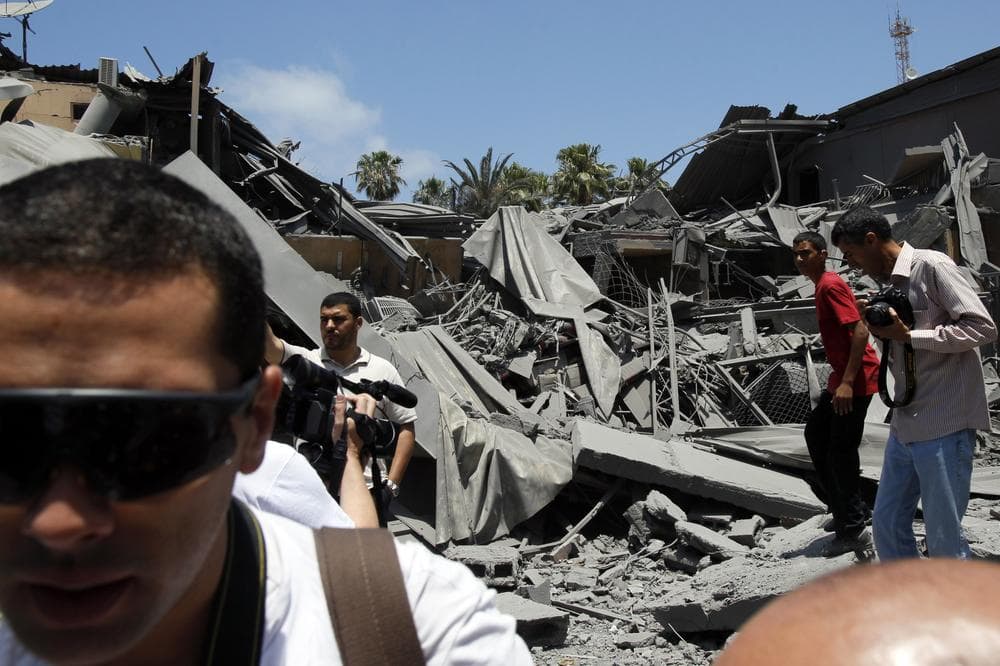Advertisement
NATO Air Strikes Continue In Tripoli
Resume
Here & Now Guest:
- Jeremy Bowen, the BBC's Middle East editor
By: THE ASSOCIATED PRESS
WASHINGTON - The U.S. is paying two European mine-clearing groups nearly $1 million to hunt and dispose of loose anti-aircraft missiles that could make their way from Libyan battlefields to terror groups.
The hiring of weapons demolition experts hardly dampens concerns about anti-aircraft missiles still in the hands of the Gadhafi regime's military, which amassed nearly 20,000 of the weapons before the popular uprising started in March.
The State Department's hiring of British and Swiss weapons demolition teams in Libya to search for missiles, mines and other deadly munitions was prodded by fears that terrorists could use scavenged man-portable air defense systems, known as MANPADS. The action came after American and allied authorities made it clear to Libyan opposition figures that their cooperation on the missile launchers would be a factor in future assistance, said U.S. and United Nations officials familiar with the discussions.
"From the U.S. point of view, it was an issue of paramount importance," said Justin Baker, officer-in-charge of the U.N. Mine Action Service, which is overseeing the weapons disposal effort in Libya. "The Libyans seemed to get the big picture of what was necessary to present a credible international face."
The move has no effect on the massive numbers of mostly Russian-built anti-aircraft launchers and missiles still in the hands of Moammar Gadhafi's forces. While some shoulder-held and truck-mounted launchers were pillaged by rebel forces when they seized Libyan ammunition stocks, the vast majority are still held by the regime.
"I can't imagine the U.S. can do anything about Gadhafi's inventory until they defeat him or negotiate his exit," said Matthew Schroeder, an arms expert with the Federation of American Scientists in Washington. "But even without that, securing any MANPADS loose in Libya is a good thing."
The Obama administration listed the nearly $1 million anti-MANPADS effort this week in a report to Congress defending the legality of its intervention in Libya. The report included classified documents detailing a "threat assessment of MANPADS, ballistic missiles and chemical weapons in Libya."
Most U.S. warplanes have electronic evasion systems and can fly above the range of the missiles, but most passenger jets are vulnerable. Reports have surfaced in recent weeks from officials in Algeria and Chad, and recently from Russian media, that several anti-aircraft missiles and launchers looted from Libyan government caches have already wound their way to the North African terror group, al-Qaida in the Islamic Maghreb. American officials have yet to confirm any of the reports.
Officials with the two firms hired by the State Department, the British-based Mines Advisory Group and the Swiss Foundation for Mine Action, said almost all of the Libyan weapons depots they surveyed in recent weeks showed clear signs of looting. Libyan opposition forces took almost any useful weapon from Gadhafi regime stocks in the opening weeks of the conflict, and search teams have found few inventory documents, so it is impossible to trace which are missing and whether any were sold to terrorists or criminal gangs.
"The ammo dumps we've seen are either partially destroyed or picked clean," said Alexander Griffiths, director of operations for the Swiss group, which now has 35 disposal experts working in rebel territory under a $470,000 U.S. grant. "We haven't seen MANPADS so far and my guess is we won't see many because they're such a high-value item. They would be the first items to go."
The British mine disposal group located and destroyed two of the portable missile systems near the northeastern Libyan opposition-controlled town of Ajdabiya last week, spokeswoman Kate Wiggans said. The group also found two other stray anti-aircraft missiles in May and destroyed them. All four were SA-7s, Russian-made portable missiles that date to the 1970s. Experts say many Libyan MANPADS are probably of similar vintage and some may be too decayed to use.
The Mines Advisory Group has three workers in Libya but plans to expand to at least 20, operating with $486,000 in State Department funding and $290,000 in British government aid, Wiggans said. Both she and Griffiths said that their demolition experts were taking care to avoid hot battle zones, coordinating with U.N. officials overseeing relief efforts in opposition-held turf.
U.S. officials would not say whether the funding would continue beyond the end of the year. The U.S. has been the lead player in efforts to round up and destroy stray missiles, hiring contractors like the two European firms to scour battlefields and, in some cases, discreetly paying armed governments like Yemen to turn over missile stocks. The U.S. programs have destroyed 32,500 missile systems in 30 countries since 2003, but officials say thousands more still pose a hazard among the estimated 1 million manufactured since the late 1960s.
Passenger flights have never been targeted inside the U.S. Nearly a dozen lethal strikes have brought down passenger and cargo planes over the past decade in Africa and Asia.
This segment aired on June 17, 2011.